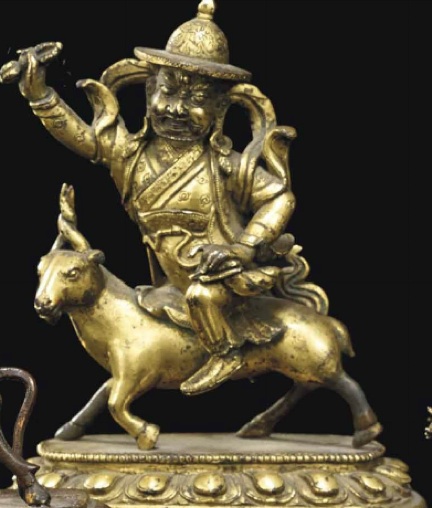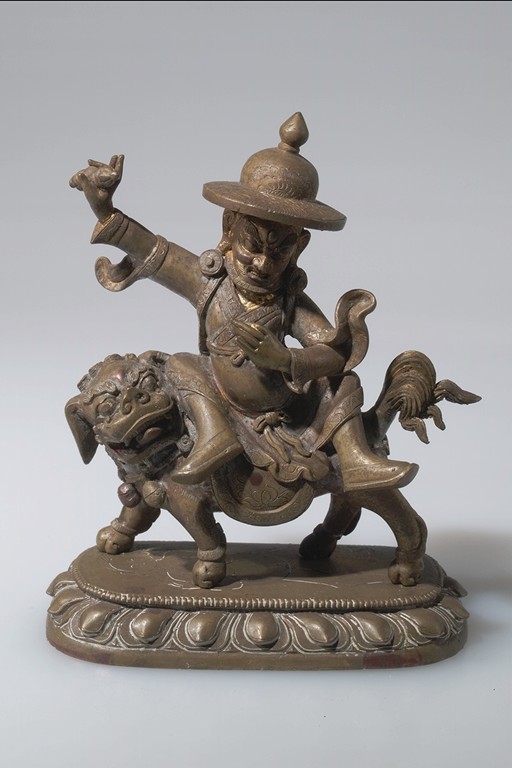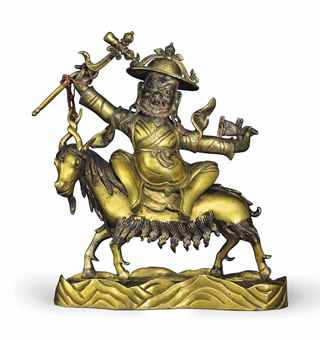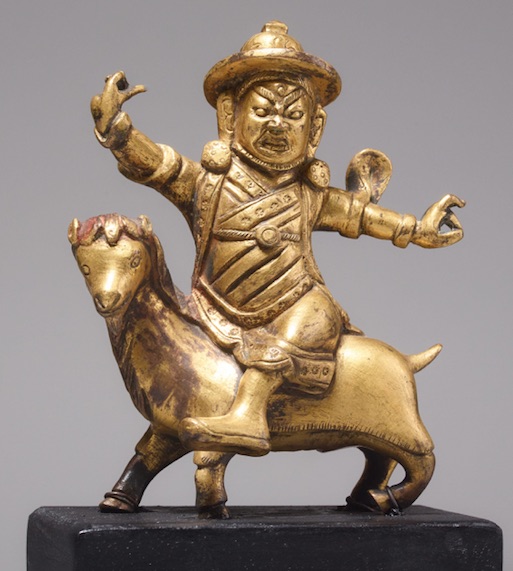
18th century, Tibet, Dorje Legpa (labelled ‘dam.can’), gilt copper alloy, private collection, photo on Christie’s, Paris
Dharma protector Dorje Legpa, a type of dam.can also known as Vajra Sadhu in sanskrit, rides a Tibetan billy goat with crossed horn, and holds a vajra sceptre in his right hand and a human heart in the other (it is not clear what the above holds). He wears silk garments adorned with an incised motif, boots, a celestial scarf and his usual hat.
The form of Pehar who rides a lion normally has three heads and six arms. Dorje Legpa in his two-hand form may ride a lion, a goat or a camel. He holds a vajra sceptre in his right hand and a human heart in the other, as the above figure. Both may wear a cymbal-shaped hat.

Undated (circa 18th century), Tibet, Dorje Legpa, metal, at the American Museum of Natural History (USA).
He may also ride a snow lion.

18th-19th century, Tibet, Dorje Legpa, gilt copper alloy, at the Ashmolean Museum in Oxford (UK).
This sculpture depicts him in his 3-head and six-arm version, riding a snow lion. In his right hands he holds a stick, a (missing) arrow, and a vajra sword, in his left hands he holds a vajra knife (with a vajra handle), a bow, and a (missing) vajra pike.

Circa 18th century, Tibet, Garwa Nagpo, gilt copper alloy, private collection, photo on Christie’s
Dorje Legpa’s attendant, Garwa Nagpo holds in his right hand a vajra hammer (said to be made of meteorite iron according to the Himalayan Art Resources website) and, in his left hand, some bellows (supposed to be made of tiger skin). On this sculpture, his mount is crossing an ocean of blood.

18th century, Tibet or China, Garwa Nagpo (labelled ‘Palden Lhamo’), gilt bronze, private collection, photo on Hardt .
Seated sideways on a goat with twisted horns, his arms stretched horizontally to display his hammer and bellows (now lost in this case), Garwa Nagpo is the patron saint of blacksmiths, and a special protector of the Gelug order. He has a damcan appearance, i.e. very irate, with three eyes, bared fangs, long silk garments that cover both arms, felt boots. On paintings he has flaming orange hair and is adorned with a five-skull crown and earrings, as above.

18th-19th century, Tibeto-Chinese, Dorje Legpa (or Garwa Nagpo?), gilt copper alloy, at the Ashmolean Museum in Oxford (UK)
The attributes are missing from this figure, but he rides a Tibetan goat with entwined horns, like Garwa Nagpo.






































